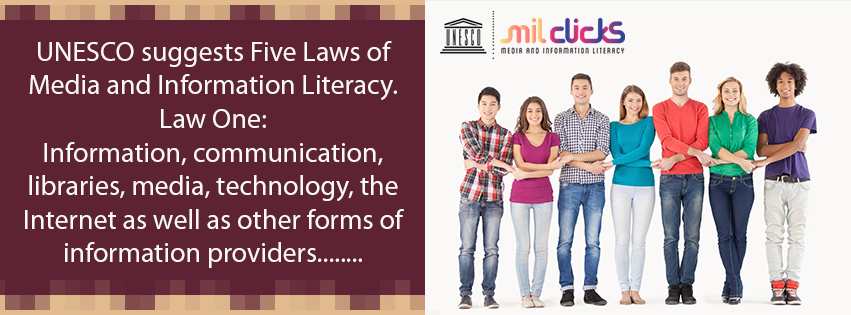Five Laws of Media and Information Literacy
We are travelling towards the universality of books, the Internet and all forms of “containers of knowledge”. Media and information literacy for all should be seen as a nexus of human rights. Therefore, UNESCO suggests the following Five Laws of Media and Information Literacy.
They are inspired by the Five Laws of Library Science proposed by S. R. Ranganathan in 1931. The Five Laws of MIL are intended as guides, together with other UNESCO resources, for all stakeholders involved in the application of MIL in all forms of development.
For more context to the Five Laws of MIL, please see related chapter in the MIL Yearbook 2016 published by UNESCO, Media and Information Literacy: Reinforcing Human Rights, Countering Radicalization and Extremism.
Law One

Information, communication, libraries, media, technology, the Internet as well as other forms of information providers are for use in critical civic engagement and sustainable development. They are equal in stature and none is more relevant cipro ciprofloxacin than the other or should be ever treated as such.
Law Two
Every citizen is a creator of information/knowledge and has a message. They must be empowered to access new information/knowledge and to express themselves. MIL is for all – women and men equally – and a nexus of human rights.
Law Three
Information, knowledge, and messages are not always value neutral, or always independent of biases. Any conceptualization, use and application of MIL should make this truth transparent and understandable to all citizens.
Law Four
Every citizen wants to know and understand new information, knowledge and messages as well as to communicate, even if she/he is not aware, admits or expresses that he/she does. Her/his rights must however never be compromised.
Law Five
Media and information literacy is not acquired at once. It is a lived and dynamic experience and process. It is complete when it includes knowledge, skills and attitudes, when it covers access, evaluation/assessment, use, production and communication of information, media and technology content.



